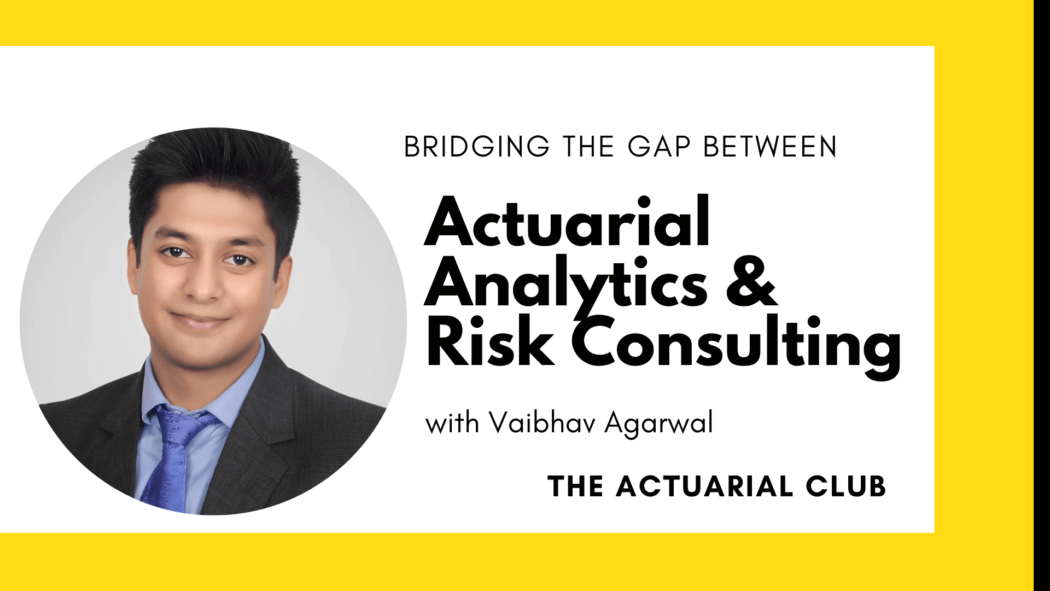Vaibhav Agarwal, an FRM and a student actuary with 12 papers cleared (CT Series- all, CP2, CP3, and SP0) have worked with Marsh & McLennan Companies, and currently working with KPMG as an Associate Consultant-FRM. Vaibhav is experienced in advanced actuarial analytics and risk consulting, building bespoke stochastic, and predictive models to quantify risk and recommend mitigation strategies. He has worked on ERM strategies, D&O liability, Cyber Risk, and Environmental Liability among others.
We asked him a few questions regarding our profession and here are his responses to those questions.
TAC: What path should a fresher adopt in case they want to join actuarial analytics or/and a Risk Consulting team?
Vaibhav: I think where you land your first job has got a lot to do with luck. Having said that, one’s got to make their part of the effort to have the best odds at getting the desired field – be it Life, General or Risk Consulting. A key tip would be to prepare well for the interview – they usually go way beyond the CV. Specifically in consulting interviews, owing to the diversity of the work, one of the expectations is an ability to use standard concepts and tweak them for problem-solving. One could use an equity pricing model to value an insurance product – they’ve both got to do with the Risk-Reward Theory.
Especially for actuarial folks, 3 generic components of any model would be Inputs, Parameters and Outputs – be it a GLM, a Time Series, or a simple linear model.
Vaibhav Agarwal on Model
As long as one can tailor these components for the purpose of the model, I think they’ve got a good shot at consulting as a fresher. A helpful exercise would be to pick a simple business problem or question, gather relevant data from google, and try answering some questions based on data- helps to sharpen insight into the usage of numbers to answer questions.
TAC: What’s a good path to develop the technological skills needed for the industry (Eg: VBA, R)?
Vaibhav: I believe self-learning is the best learning, better than what online courses usually offer. The way I learned R or VBA wasn’t through a website – I always forgot the lectures or codes, and it’s a problem that most students face. I took a seniors recommendation and adapted to Google – it’s literally got answers to everything. I used to randomly pick a simple exercise, Eg: Copy a column of Excel to another sheet using VBA. I used to google the code and write a copy of the code for my exercise.
Took some time, but I was able to copy a column using VBA, relate to it, and understand exactly what the code meant. Over the days, I started picking more sophisticated exercises and in a few weeks, I was able to write VBA codes to automate Excel models.
In my opinion, the self-learning helped me retain the knowledge and relate with it better, and it would definitely help in learning software.
TAC: How are Actuaries involved in Risk Consulting and what are their responsibilities?
Vaibhav: In my limited experience, Risk consulting is particularly tricky with the subjectivity involved – no data can give a certain outcome for the future. Ergo, in the case of relatively larger companies, risk management requires multi-functional teams that identify foreseeable risks, mitigate it, prepare for it and manage it. A lot of it has to include subjective opinions and assumptions about what might happen in the future.
A key responsibility of an actuarial professional would be the minimization of such subjectivity. One of the expectations could be to analyze data, transform it into objective information, and use the information to make decisions. Data-driven answers are usually preferred to subjective ideas. The predictions don’t have to be accurate; all they have to do is help make a decision. Like they always say, “All models are wrong, some models are useful”.
TAC: How’s your experience been with an FRM certification complementing with Actuarial Science?
Vaibhav: In all fairness, the two curriculums do have considerable overlap. In terms of benefits gained, FRM has definitely helped me boost my actuarial career. Over the couple of years of my work, I’ve encountered multiple occasions where I could leverage upon concepts from FRM to enhance actuarial models.
One simple example could be capturing the effect of market volatility into predicting the loss from risk. It has helped me relate better with other risk teams when they talk strictly in terms of Financial Risk and provide better and integrated ideas. We’ve all usually got to work with multiple teams and collaborate on solutions. FRM has proved to be helpful in such situations.
TAC: What kind of work is required to build an ERM strategy for multinationals and the work of Actuaries there?
Vaibhav: Considering the diversity of the risks faced by these corporations, multiple teams work on an ERM strategy to implement strategies that minimize risk. The first step is usually the identification of possible risks faced and it usually goes way beyond Financial risks- consider the risk that a university might face if artifacts were damaged at their in-house library, or if a shooting were to happen on campus. Actuaries can especially help identify risks that can be insured. Extensive modeling goes into predicting a foreseeable loss from such cases, identifying correlations between them, and recommending an insurance structure that covers all such risks adequately. Constrained by the budget of a firm, not everything can be insured – premium payments need to be kept low. A key responsibility for actuaries could be to predict the outcomes and insure just what’s needed and not over-insure.
TAC: Usually which tools and software are used for performing risk Quantification, Capital Modelling, Pricing and Reserving?
Vaibhav: In simpler cases, Excel models or VBA-driven models do the work. However, with a little complexity, and with a shift of focus to stochastic modeling, R, Python and @Risk have been helpful with providing the functionality to statistically analyze data, run algorithmic models and simulate scenarios -running a million simulations might not be as simple with Excel. That being said, the Risk committees usually want interpretable outputs, ones that they can play around with and understand. One approach that I’ve used in the past is to run the models in R and provide simple graphical or tabular outputs in Excel, it helps us explain them better to a client and helps the clients relate better to our solutions.
TAC: Can actuaries via Analytics or any other means add value to Business strategy or areas outside of Risk Management?
Vaibhav: In my opinion (and I’m happy to stand corrected), the curriculum equips us with a generic skill-set to drive decisions based on numbers, be it any domain. I remember working on a project where we tried to put a number on the ROI of cyber control systems in place for an IT company, using cost-benefit analysis.
It helped the client not only procure adequate Cyber Risk Insurance, but also decide what controls to put in place, and the amount to invest in such controls. Such information could be a considerable value add during negotiations with suppliers of control solutions. Or simply, It could be analyzing the correlations between products sold at a supermarket, and recommending the stocks of products to be kept available.
TAC: What has been your approach to developing innovative solutions for clients as a bridge between Actuarial Analytics and Risk?
Vaibhav: Problem-solving is a service that actuarial professionals provide to clients- usually these problems are about the uncertainty of the future. Certain components of these problems are fairly predictable – a company might just know the number of employees it’s going to have next year. The approach I take is to break a problem down into pieces, and address each part separately and put the solutions back into the block.
Consider the example – workers’ injury claims from all offices across the globe. The client would be aware of the number of offices and employees. All we need is a likelihood of claims from each office and an estimated amount for the claims- that’s relatively solvable once we’ve analyzed some data. Ergo, basic math could help solve complicated questions for clients.
Thank you so much, Vaibhav for taking out time from your schedule and sharing your experience with us. Feel free to connect with Vaibhav on Linkedin! Wishing you luck for your future endeavors. May you achieve greater heights.

